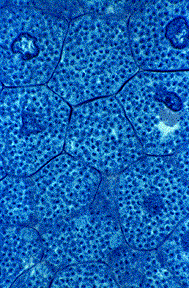Study plots nitrogen web that feeds the world
 European scientists have made progress on efforts to better understand the relationship between the ocean, certain microbes and nitrogen that feeds much of the planet.
European scientists have made progress on efforts to better understand the relationship between the ocean, certain microbes and nitrogen that feeds much of the planet.
A team has investigated and reported on the important microbial process which regulates the global nitrogen budget in the oceans – that is, the amount of nitrogen available in various forms to fuel life.
Every organism needs nitrogen to survive and grow, but many have to rely on a supply of nitrogen that has been ‘fixed’ by others – because they cannot obtain nitrogen from molecular nitrogen (N2), the major component in the atmosphere. Ocean-dwelling microbes step in and perform this conversion so that much of the rest of life on Earth can continue.
The availability of fixed nitrogen, in the form of ammonium, nitrite and nitrate, consequently often limits primary production in the environment.
There is also a slightly more mysterious reverse effect though, where microbial processes convert fixed nitrogen back to N2, producing of energy instead of growth. Scientists call this process loss of fixed nitrogen, because it removes the important fixed nitrogen from the environment, and thereby limits production of biomass.
In the water column of the ocean, nitrogen-loss processes are most prominent in water bodies known as oxygen minimum zones (OMZs), where dissolved oxygen (O2) is almost completely consumed.
There has been major concern that OMZs will expand in the future due to shifting climate conditions, which could have a massive impact on the amount of nitrogen lost from the marine realm, affecting the primary productivity in the ocean.
The researchers behind a report in the latest US journal Proceedings of the National Academy of Sciences, explain their method for plotting these related nitrogen processes to try to unravel their full purpose.
Ben Brunner, one of the three main authors, explained: "We can answer this question with the help of stable nitrogen isotopes, by looking at the ratio between the stable isotopes 15N and 14N in the different pools of fixed N and in the produced N2, because different microbial processes leave different N isotope fingerprints; some prefer the light isotope 14N over the heavier isotope 15N, and others do the opposite."
Sergio Contreras, a paleo-biogeochemist interested in the past and future of the nitrogen cycle, continued: “However, the prerequisite to decipher the N isotope signatures in the environment is to know the isotope fingerprint of the individual nitrogen-loss processes.”
Moritz Lehmann, isotope biogeochemist from the University of Basel, reports: “This is where so far, there was a gaping hole in our knowledge. The isotope effects of one major N-loss process, namely anammox, were unknown, and previous N-isotope based assessments of fixed N loss rates in the global ocean may have been severely biased.”
Boran Kartal, microbiologist at Radboud University Nijmegen, says: “We used the highly enriched cultures that are available in our laboratory to determine the nitrogen isotope effects of anammox bacteria. Our findings show that the isotope effects induced by anammox can explain isotope signatures observed in the OMZs, which are very important primary production sites in the oceans.”
Marcel Kuypers, director at the Max Planck Institute, concludes: “This missing piece of information is of utmost importance to solve the nitrogen isotope puzzle, not only because anammox is an important process in OMZs, but also because anammox simultaneously affects the nitrogen isotope composition of all nitrogen pools of interest: it converts ammonium and nitrite to N2 and nitrate.”
Their results help reconcile previously mysterious N-isotope patterns from OMZ, and provide a missing piece to solve the nitrogen isotope puzzle for fixed N-loss from the environment.








 Print
Print